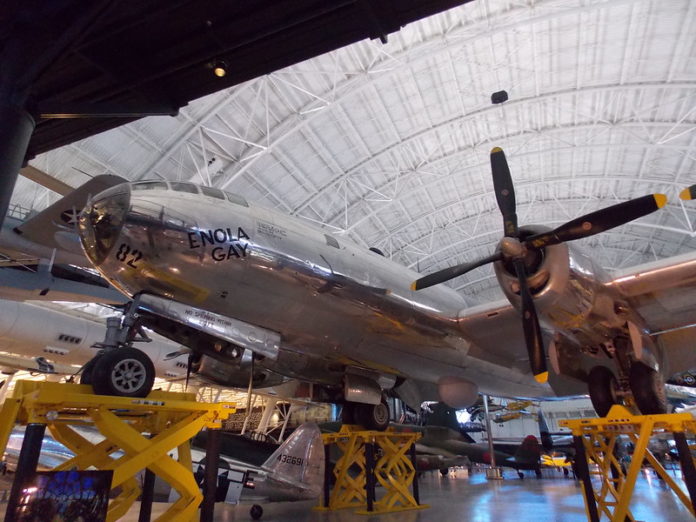At 8:15am on August 6, 1945, the B-29 bomber “Enola Gay” destroyed the Japanese city of Hiroshima with just one bomb.
“Museum Pieces” is a diary series that explores the history behind some of the most interesting museum exhibits and historical places.

In late July 1945, after the successful Trinity test of an atomic bomb in New Mexico, the US began to plan the combat use of its new weapons. Two complete bombs (Little Boy and one Fat Man) were already available, two more Fat Mans would be ready within weeks, and about one Fat Man bomb a month would be produced after that. By this time plans for the invasion of Japan were already being drawn up: the first stage (Operation Olympic) was scheduled for November 1945, and the second stage (Operation Coronet) for March 1946. It was expected that Japanese resistance would be fanatical, and that casualties on both sides would be enormous.
When the initial list of potential targets for atomic bombs was drawn up, the city of Nagasaki was not on it. The original list was Yokohama, Kyoto, Hiroshima and Kokura, with Niigata as an alternate.
Within days, though, the initial atomic target list was altered. The ancient capitol of Kyoto, though the second-largest city in Japan, was a cultural, religious, and historical center with little military significance, and the political fallout the US would receive from destroying it was not worth the gains. So Kyoto was placed on the “reserved” list: it would not be designated as a target for either atomic or conventional firebombing.
Yokohama was an important industrial center, but it had already been the target of several B-29 firebombings, and the US military wanted an intact untouched city as a target for the atomic bombs, so they could better judge the damage levels that the bomb produced. So Yokohama was removed from the list of atomic targets as well.
That left Hiroshima, Kokura, and Niigata, and on July 24, 1945, these cities were placed with Kyoto on the “reserved” list of cities that would not be hit by the firebomb raids. They would be the atomic targets, “in the priority listed”.
But shortly after that, it was decided that Niigata was too far away from Tinian for a safe delivery of the heavy atomic bomb, and Niigata was dropped from the target list. It was apparently at this time that Nagasaki was added, likely because it was the largest city still available.
The targets for the first two atomic missions were now set: for the first mission, the primary target would be Hiroshima with Kokura as secondary, and for the second mission, the primary target would be Kokura with Nagasaki as secondary. Hiroshima was an important port city and also contained the regional Japanese Imperial Army Headquarters, but it had been spared from initial bombing raids because, while there were factories that made rifles and aerial bombs, the city did not contain any of the large aircraft plants that were the B-29’s primary targets. This lack of damage, ironically, led to Hiroshima being selected as a perfect target for Little Boy: it would allow a more accurate assessment of the damage caused by the atomic bomb. In essence, Hiroshima had become a guinea pig.
For several weeks in July 1945, crews from the 509th Composite Group had been rehearsing missions in their modified Silverplate B-29s. Several Little Boy casings packed with TNT had been dropped over the Pacific Ocean to test the bomb’s various barometric switches and radar systems, which were used to detonate the device at the desired altitude. The ground crews also practiced transferring the heavy Little Boy dummies from one plane to another, in case a bomber developed mechanical troubles before takeoff. Finally, crews would fly missions over Japan, either in a lone bomber or in a group of three, and drop just one bomb on a selected target.
Few of the bomber crews yet knew what they were actually practicing for, but one of them—Colonel Paul Tibbets—did. He had been in charge of the Silverplate program, and now he often personally piloted one of the modified B-29s on these practice missions. As group commander it was his prerogative to select the men who would fly the actual bombing missions—and he had already decided that he himself would pilot the first one.
The components for Little Boy, meanwhile, had all arrived separately, under high security, at the airfields on Tinian, a tiny island in the Northern Marianas. (The uranium core was delivered by the heavy cruiser Indianapolis, which was torpedoed on its way back from Tinian.) The entire island had been converted into a complex of airfields, from which heavy air raids were launched nightly to pound Japanese cities. The Silverplates from the 509th Composite Group were now clustered off by themselves in a cordoned area of the island, where special facilities had been constructed to allow bombers to be loaded with nuclear weapons.
On July 25, 1945, the Army Chief of Staff General Thomas Handy forwarded President Harry Truman’s orders to drop the atomic bombs on Japan. The orders read: “The 509th Composite Group, 20th Air Force will deliver its first special bomb as soon as weather will permit visual bombing after about 3 August 1945.” Tibbets scheduled the mission for August 6, the first day for which good weather was predicted.
The mission would consist of three B-29s, with several more serving as weather and reconnaissance planes. Tibbets himself would fly the plane carrying the bomb: this plane, usually piloted by Captain Robert Lewis, had not even been named yet. Upon assuming command of the mission, Tibbets demoted Lewis to co-pilot, and named the plane “Enola Gay” after his mother. Two other Silverplates, one named “The Great Artiste” and the other one then-unnamed but later dubbed “Necessary Evil”, would accompany “Enola Gay” and would carry photographic equipment and scientific instruments to document the explosion. During the mission, “Enola Gay” would use the radio callsign “Dimples Eight Two”: the others would be “Dimples Eight Nine” and “Dimples Nine One”.
There would also be a technician from Los Alamos on board the “Enola Gay”. Captain William Parsons had led the Navy team which had designed and tested the gun-barrel configuration for the bomb. For maximum safety, Little Boy would be unarmed at takeoff: it was Parson’s job to open up the bomb casing once the B-29 was airborne, insert the four packages of cordite propellant, and replace the green “safe” electrical plugs with the red ones which would arm the bomb.
The Army knew that this would be a historic mission, and cameras and film crews had interviewed the crew and documented the event. “Enola Gay” rolled down the Tinian runway at 2am local time. After rendezvousing with “Great Artiste” and “Necessary Evil”, the group received a radio report from “Straight Flush”, the weather plane which was circling over Hiroshima. It read: “Cloud cover less than 3/10 at all altitudes. Advice: bomb primary.” The three bombers set their course for Hiroshima. Over the radio intercom, Tibbets now informed his crew that they were carrying the world’s first atomic bomb.
Several routine B-29 bombing missions had already been scheduled for that day, and Japanese radar had already detected five large groups of raiders headed for various cities. So when they picked up the tiny group of B-29s heading for Hiroshima, they issued an air raid warning as a standard precaution but paid little attention to it, assuming it was just another routine weather-reconnaissance mission. By the time “Enola Gay” and the others arrived over the city at around 8am local time, the “all-clear” signal had already been given. There was no anti-aircraft fire and no Japanese fighters.
At 8:08am Tibbets began his bomb run and turned control of “Enola Gay” over to the bombardier, Major Thomas Ferebee. Ferebee’s aiming point was the distinctive T-shaped Aioi Bridge near the center of the city. At 8:15, the bridge moved into the crosshairs of his bombsite. “I have it!”, Ferebee called, and pressed the bomb release. “Bombs away!”, he exclaimed—then, immediately correcting himself, he repeated, “Bomb away!”
As Little Boy fell out of the “Enola Gay’s” bomb bay, it pulled out a pair of wires that served as the first safety switch. Next, an automatic timer ran out, arming another switch that prevented the bomb from prematurely detonating too close to the bomber. Shortly afterwards, a series of barometric switches were triggered. The final step happened 43 seconds after the bomb was released, when the onboard radar sensors determined that they had reached the proper altitude above ground, and closed the last switch.
The bomb fell just short of its target, exploding directly over the Hiroshima Industrial Promotion Hall. Later studies estimated its yield as 13-15 kilotons. The death toll was somewhere between 130,000 and 150,000 people.
Later that afternoon, in the United States, President Truman made an announcement over the radio: “Sixteen hours ago an American airplane dropped one bomb on Hiroshima, an important Japanese Army base. That bomb had more power than 20,000 tons of TNT. It had more than two thousand times the blast power of the British ‘Grand Slam’ which is the largest bomb ever yet used in the history of warfare…. It was to spare the Japanese people from utter destruction that the ultimatum of July 26 was issued at Potsdam. Their leaders promptly rejected that ultimatum. If they do not now accept our terms they may expect a rain of ruin from the air, the like of which has never been seen on this earth.”
In August 1946 the “Enola Gay” was donated to the Smithsonian Institution, but because the Smithsonian had no building capable of holding it, the B-29 was stored at various Air Force bases around the country, where it deteriorated. It was finally transferred to a Smithsonian storage hangar in 1960, but restoration work was not begun until 1984. The forward fuselage was on display at the Air and Space Museum for several years in the late 90s, but in 2003 the renovated “Enola Gay” was completely re-assembled and went on public display at the Smithsonian’s Udvar-Hazy Center.
NOTE: As some of you already know, all of my diaries here are draft chapters for a number of books I am working on. So I welcome any corrections you may have, whether it’s typos or places that are unclear or factual errors. I think of y’all as my pre-publication editors and proofreaders. 😉








